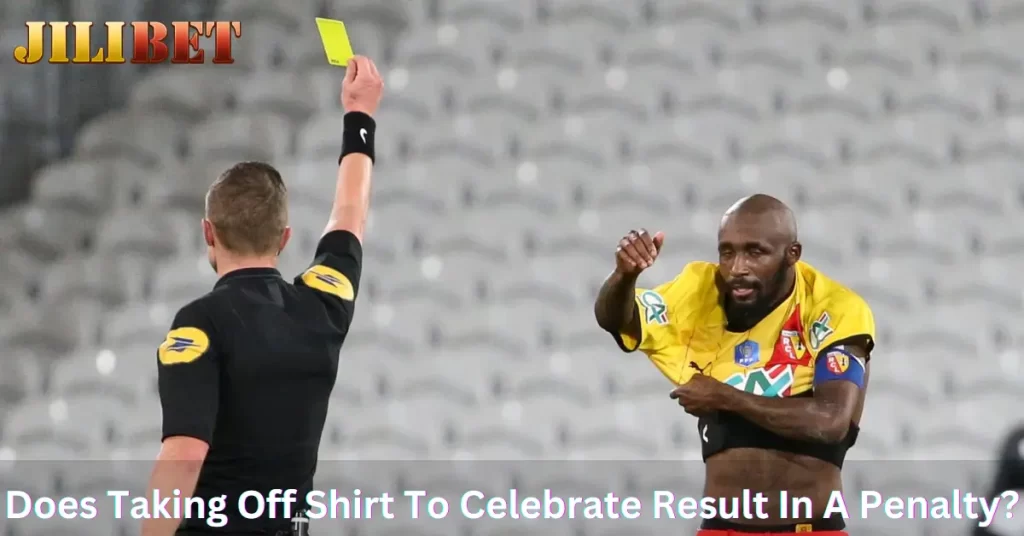Overview – Why do players get booked for taking shirt off?
The regulations on match attire are among the 17 laws established by the International Football Association Board (IFAB) in the latest Laws of the Game. These regulations are applied uniformly across all forms of football, including official outdoor matches, futsal, and beach soccer. The rules are enforced worldwide in every participating nation. So, Why do players get booked for taking shirt off? Let’s find it out with Jilibet.
There are a total of 17 laws in the official Laws of Football. These laws are designed to apply universally across all levels of the game, though national football associations are permitted to adapt them for youth leagues, amateur matches, or women’s competitions. Typically, the laws provide a flexible framework that can be adjusted based on the specific nature of the game. In addition to these 17 laws, numerous decisions and guidelines from IFAB are integrated into the Laws of Football.
Why do players receive a yellow card for taking shirt off?
After scoring a goal, players are often overwhelmed with emotion, and taking shirt off, exactly – taking their shirts off jersey is one of the most expressive ways to celebrate. The exhilaration of the fans witnessing this moment, combined with the celebratory shouts of the scorer, is indescribable. However, why did FIFA introduce a rule that seems to “suppress” the emotions of players and fans alike?

The main reason for this regulation is that some players have exploited shirt removal to display non-sporting messages printed on their undershirts. These messages may involve religious, political, or commercial content promoting specific brands. Additionally, removing a jersey can be seen as culturally inappropriate in certain countries.
Players are not allowed to remove their shirts while celebrating during a match. This is explicitly noted in IFAB’s Laws of the Game.
The rule penalizing players with a yellow card for taking their shirts off first came into effect in 2004 for several reasons. Primarily, it aims to minimize unnecessary time-wasting and also addresses the act as potentially unsportsmanlike behavior.
=> Read more: What is a Red Card in Football? What Offenses Result in a Red Card?
FIFA’s regulation on yellow card penalties for taking shirt off
According to FIFA’s official guidelines:
- Players may celebrate scoring a goal but must avoid excessive displays. Pre-arranged or overly theatrical celebrations are discouraged and should not waste excessive time.
- Leaving the pitch to celebrate a goal is not a yellow-card offense, but players are encouraged to return to the field as quickly as possible.
A player must be cautioned even if the goal is disallowed for actions such as:
- Climbing the perimeter fence or engaging with spectators in a way that could cause safety or security issues.
- Celebrating provocatively, mocking, or inciting others.
- Covering the head or face with a mask or similar item.
- Removing the shirt or using it to cover the head.
MATCH ATTIRE REGULATIONS IN THE LATEST FOOTBALL LAWS
In football, match attire regulations aim to protect players’ bodies from abrasions and help distinguish players between the two competing teams. Football players typically wear jerseys with numbers printed on the back. Each player is assigned a fixed number for the entire season. Teams often print player names alongside their numbers or, alternatively, the team’s name, or both.
Evolution of Football Attire

Football attire has become increasingly optimized over time. In the past, players wore long cotton shirts and heavy, rigid shoes that hindered mobility. Today, football boots are lighter and better-fitted, and jerseys are made from lightweight, durable materials that can feature vibrant colors and various designs.
With the development of advertising, sponsor logos are frequently printed on jerseys, particularly for club teams. However, for national teams, player numbers are typically printed on both the front and back of the jerseys, as well as the front of the shorts.
=> Read more: Effective Basketball Betting Strategies and Mistake You Should Avoid
Basic Match Attire
The essential attire for players during a match includes:
- Team jersey: Each team has unique designs. If wearing an undershirt, it must match the jersey color.
- Shorts: If wearing thermal shorts underneath, they must match the outer shorts’ color.
- Long socks
- Shin guards
- Football boots
- Players are not allowed to wear one-piece suits.
- Players must not expose undergarments with slogans, advertisements, or other messages, nor pull their jerseys over their heads or completely remove them, except in cases of goal celebrations. Violating attire rules typically results in penalties.
- Players may use protective gear such as glasses, caps, masks, or wrist and finger bands, provided these items are deemed safe by referees and organizers.
- During winter, players can wear winter gear in compliance with regulations.
Shin Guard Regulations

- Shin guards must be made of rubber, plastic, or similar materials.
- They must be fully covered by socks and provide adequate protection.
Goalkeeper Attire Regulations
Goalkeepers have distinct attire that must differ in color from their teammates, opponents, the opposing goalkeeper, and referees. Goalkeepers may wear long sports trousers or shorts, similar to outfield players.
Referee Attire
Although not explicitly stated in the Laws of the Game, referees typically wear attire in a color distinct from both teams’ kits and the goalkeepers.
=> Are you looking for a reputable and top-quality casino for betting? Try our partners: Slotvip.
Penalties for Violating Attire Regulations
For breaches of Law 4 (The Player’s Equipment):
- Play does not necessarily stop for attire violations.
- The referee will ask the offending player to leave the field to adjust their attire to comply with regulations.
- If the ball is out of play, the player must leave the field to correct their attire unless it is adjusted beforehand.
- A player must receive permission from the referee to re-enter the pitch after correcting their attire.
- Before rejoining, the referee will inspect the player’s attire for compliance.
- If a player re-enters without permission after adjusting their attire, the referee will stop the game, caution the player, and restart play with an indirect free kick for the opposing team from the spot where the ball was when the match was stopped.
These are the latest global match attire regulations established by IFAB and implemented worldwide.

Launched in 2017, JILIBET began its odyssey, serving the Philippines entertainment and gambling. JULIET is a Filipino-owned corporation – Ms.Carmen Dela Rosa, the CEO of Jilibet Casino, is a visionary leader who has been instrumental in driving the brand’s growth since its founding.


My spouse and I absolutely love your blog and find the majority of your post’s to be exactly
what I’m looking for. Do you offer guest writers to write content for you
personally? I wouldn’t mind creating a post or elaborating on a number of the subjects you write concerning here.
Again, awesome weblog!
Great post. I was checking constantly this blog and I’m impressed!
Extremely helpful info specially the last part 🙂 I care for such information much.
I was looking for this certain information for
a long time. Thank you and best of luck.
Asking questions are really fastidious thing if you are not understanding anything entirely, except this post gives nice understanding yet.
I do not even know how I ended up here, but I thought this post was
good. I do not know who you are but certainly you are going to a famous blogger
if you are not already 😉 Cheers!
I’m really impressed with your writing skills and also with the layout
on your weblog. Is this a paid theme or did you modify it yourself?
Anyway keep up the nice quality writing, it is rare to see
a great blog like this one nowadays.